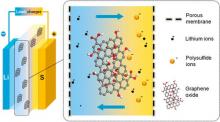Researchers at China's Tsinghua University used ion-selective membranes of ultrathin graphene oxide (GO) to develop a novel, ion-selective but highly permeable separator for significantly improving both the energy density and power density of lithium-sulfur batteries. This resulted in a highly-stable and anti-self-discharge lithium-sulfur cell.

Polysulfides are materials generated at the cathode side, diffuse through the membrane, react with lithium anode, and shuttle back. During the process, polysulfides dissolve and irreversibly react with metal lithium and organic components, inducing the destruction of the cathode structure, depletion of the lithium anode, and loss of active sulfur materials. Commonly used separators in battery systems are porous polymer membranes, which separate the two electrodes while having little impact on the transportation of ions through the membrane. The researchers' design was of a GO membrane, sandwiched between cathode and anode electrodes, which efficiently prohibited the shuttle of polysulfides through the membrane.
GO separators are able to block polysulfide by electrostatic repulsion and steric exclusion, which are efficient in long-term inhabitation of the shuttle effect. Also, the typical 2D structure of GO flakes can reduce the loading amount to form an effective polysulfide shield layer.
The team's experiments showed that with the incorporation of a permselective GO membrane, the lithium-sulfur batteries afforded an improved Coulombic efficiency from 67-75% to over 95-98% at 0.1 C. The cyclic capacity decay rate was also reduced from 0.49 to 0.23% per cycle. The open circuit voltage of a normal cell with a conventional membrane decays drastically from 2.5 to 2.18 V in 5 hours. When the GO membrane was as a separator, the open circuit voltage remained at 2.5 V for more than 30 hours due to the prevention of high-order polysulfides diffusion. This indicated the self-discharging was significantly inhibited with the incorporation of GO membrane."This work shows that a GO membrane with highly tunable functionalization properties, high mechanical strength, low electric conductivity, and facile fabrication procedure, is an effective permselective separator system in lithium-sulfur batteries.
This work offers a general strategy to integrate GO membranes into rechargeable battery systems, which is crucial for illustrating the potential of functional membranes for advanced energy storage and understanding the dynamic changes on the electrode. Such an approach may also provide a novel cell configuration applicable to lithium-air batteries and fuel cells, which require delicate control of ion transport for high performance devices.